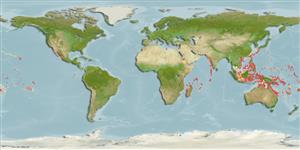Environment: milieu / climate zone / depth range / distribution range
Ecologia
marino associati a barriera corallina; distribuzione batimetrica 1 - 30 m (Ref. 58302), usually 5 - 20 m (Ref. 27115). Tropical; 22°C - 26°C (Ref. 27115); 32°N - 26°S
Indo-Pacific: Natal, South Africa (Ref. 11228) and Madagascar to the Hawaiian Islands, north to southern Japan, south to the southern Great Barrier Reef.
Size / Peso / Age
Maturity: Lm ? range ? - ? cm
Max length : 4.6 cm SL maschio/sesso non determinato; (Ref. 1602)
Short description
Chiavi di identificazione | Morfologia | Morfometria
Spine dorsali (totale) : 7; Raggi dorsali molli (totale) : 6 - 9; Spine anali: 1; Raggi anali molli: 6 - 9. Characterized by semi-transparent reddish body color, blends in well with host gorgonian; iris with gold inner ring, broad red outer ring; 2-4 lowermost pectoral rays are unbranched; longitudinal scale series 37-79; short and cup-like pelvic fins; thickened and lobed skin surrounding pelvic spines; opening of gill extending ventrally to below pectoral fin base (Ref. 90102).
Benthic (Ref. 58302). Live exclusively on, or in close association with gorgonian seawhips Junceella fragilis and Junceela juncea which usually occur in groups in areas exposed to currents at depths of 5 to more than 30 m (Ref. 1602, 58302). May also live on other species like Ellisella maculata, or even on mooring lines (Ref. 1602). Also Ref. 48637.
Life cycle and mating behavior
Maturità | Riproduzione | Deposizione | Uova | Fecundity | Larve
Benthic spawner.
Myers, R.F., 1991. Micronesian reef fishes. Second Ed. Coral Graphics, Barrigada, Guam. 298 p. (Ref. 1602)
IUCN Red List Status (Ref. 130435: Version 2024-2)
Threat to humans
Harmless
Human uses
Pesca: commerciale; Acquario: Commerciale
Strumenti
Special reports
Download XML
Fonti Internet
Estimates based on models
Preferred temperature (Ref.
123201): 24.7 - 28.9, mean 27.7 °C (based on 518 cells).
Phylogenetic diversity index (Ref.
82804): PD
50 = 0.5000 [Uniqueness, from 0.5 = low to 2.0 = high].
Bayesian length-weight: a=0.00724 (0.00339 - 0.01546), b=3.10 (2.92 - 3.28), in cm total length, based on LWR estimates for this (Sub)family-body shape (Ref.
93245).
Trophic level (Ref.
69278): 3.2 ±0.3 se; based on size and trophs of closest relatives
Resilienza (Ref.
120179): Alto, tempo minimo di raddoppiamento della popolazione meno di 15 mesi (Preliminary K or Fecundity.).
Fishing Vulnerability (Ref.
59153): Low vulnerability (10 of 100).
Nutrients (Ref.
124155): Calcium = 243 [103, 522] mg/100g; Iron = 1.05 [0.50, 2.11] mg/100g; Protein = 17.8 [15.8, 19.5] %; Omega3 = 0.104 [0.042, 0.222] g/100g; Selenium = 25.4 [10.3, 64.5] μg/100g; VitaminA = 143 [36, 543] μg/100g; Zinc = 2.78 [1.71, 4.30] mg/100g (wet weight);
